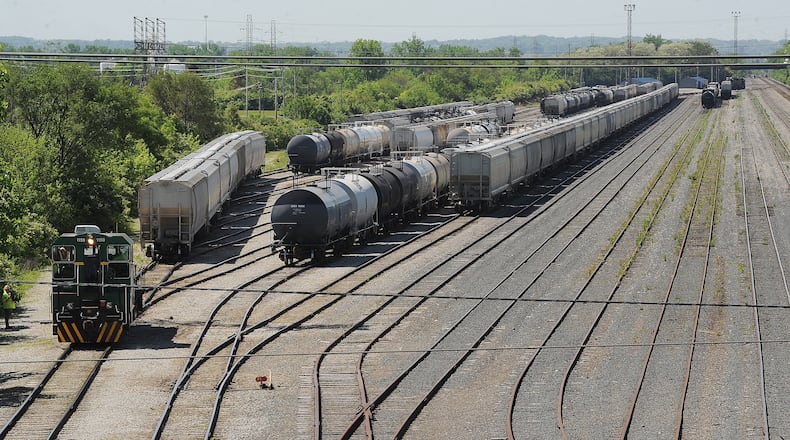“Dayton, second only to Columbus in a sheer population standpoint, is really going to be the key to having this discussion, particularly at the state and federal level,” said All Aboard Ohio Executive Director John Esterly.
Passenger rail service was discontinued in Dayton in 1979. Amtrak’s vision for the 3C+D passenger rail route would include proposed stations in Dayton, Springfield, Cincinnati, Columbus, Delaware, Crestline and Cleveland, with the new route becoming available by 2035.
The route would include three daily round-trips, and the travel time between Cincinnati and Cleveland would be less than five hours. Amtrak estimates this route would have up to 500,000 riders annually.
“These new rail connections would improve mobility for underserved communities and provide reliable and efficient transportation to education and employment opportunities along the route,” according to Amtrak plans for the 3C+D line.
Amtrak strategy
Esterly said the 3C+D route is among the top priorities for Amtrak’s vision for the future of rail transportation because the predominance of the service’s existing routes that run east of the Mississippi River traveling east and west. The 3C+D route runs north and south.
“Adding a north-south leg really does help bolster their routing,” Esterly said. “It also connects central Ohio in a meaningful way, which is the largest municipal region in the country that doesn’t have support through the Amtrak network or other passenger rail providers.”
Dayton officials, from an operational and economic development perspective, have pointed to South Ludlow and West Sixth Streets as the premier location for a Dayton-area train station.
This was the location of the former Dayton Union Station before it was closed and mostly demolished. What’s left today is an elevated platform for rail, with nothing underneath. The ground level used to be a waiting area.
Passenger rail by 2035?
The Ohio Rail Development Commission’s $500,000 first phase of its passenger rail study, paid for completely by the federal government, focused on developing a service plan.
The second phase of the state’s passenger rail study will include service development and is expected to take two to three years. It will identify required capital projects and include financial planning and public engagement. Planners will work to determine ticket pricing, economic impact, rail speed and more over the next few years.
The third phase of that study will also determine the environmental impact and preliminary engineering. The state will have to fund 20% of this phase of the study.
All Aboard Ohio Chairman and Cincinnati native Mitch Radakovich said his organization will be advocating for funding for this final phase to be included in Ohio’s next biennial budget.
“We want to make it impossible to step back on this,” said Radakovich. “But we will be much more confident that this is a reality when we get funding for Phase 3.”
State lawmakers recently passed their biennial budget, removing a seat from the Ohio Rail Development Commission that was set aside for a passenger rail representative and forgoing participation in the Midwest Interstate Passenger Rail Commission.
Federal funding remains intact
Federal support for passenger rail planning continues.
In 2021, the Biden administration announced a $66 billion investment in passenger rail. That funding does not expire until 2026.
Under the “Big, Beautiful Bill” approved by President Donald Trump earlier this month, Amtrak received stagnant funding compared to the previous fiscal year. The federal budget also includes substantial funding for other train-related projects, particularly in the freight rail sector.
Amtrak is the primary passenger rail service in the U.S., and it carried 33 million passengers last year. It services 500 destinations across 46 states and currently has separate routes that travel through Cleveland and Cincinnati. The passenger rail service often utilizes freight tracks.
“An improvement to a freight rail that Amtrak also goes over is going to be enjoyed by everybody who uses it,” Esterly said. “I think cautious optimism is where I’m at right now.”
Transportation and economic development
The overall bill for implementing this kind of infrastructure will be determined over the next few years. But passenger rail advocates say that connecting Ohio’s major cities would be very beneficial for tourism and business and job growth.
Economics and public policy group Scioto Analysis estimated that the overall economic impact of passenger rail in the Greater Dayton region, which includes Dayton and Springfield, could be up to $9 million annually and could generate up to 280 jobs, most in the construction industry.
But it also helps citizens who can’t, or don’t want to, use a car to travel.
“We’ve heard from grandparents who are unable to drive and want to go visit their grandkids in other cities. We’ve heard from people who need health care access — they need to get to Cleveland for their cancer screening,” Radakovich said.
About the Author


